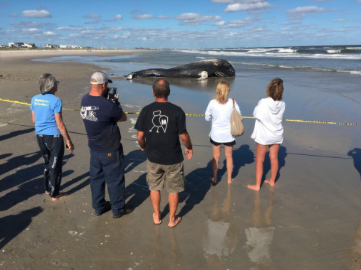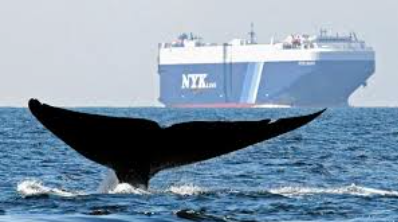Humpback Whale Washes Ashore In Sea Isle City, Nj; 09/16/16

On September 16th, a Humpback Whale washed ashore on 20th street beach in Sea Isle City NJ. The whale had been spotted earlier in the day off the coast of Strathmere, and eventually made its way down to Sea Isle City where it washed ashore. Crews responded immediately, and moved the whale further up the beach where it sat overnight. The following day, September 17th, a crew from the Marine Mammal Stranding Center arrived to perform a necropsy on the whale. While the whale was entangled in line, Bob Schoelkopf of the stranding center stated, “It’s really been dead to long to determine if being entangled in the line is what killed it”(2). Through the necropsy, Schoelkopf was able to determine that the whale had been struck by a vessel, and believes that it may have happened after the whale had already died. The whale measured out at around 33 feet, and determined to be a young male(2).

Onlookers viewing the whale behind caution tape in Sea Isle City.
This was the second whale to wash ashore dead on the beaches of New Jersey this summer, so question is what caused these large creatures untimely death? There are several threats to Humpback’s that exist off the coast of New Jersey. One of the most prominent threats that exists is vessel strikes. While it could not be determined whether or not a vessel strike was the cause of death with this individual, there are several reported strikes of Humpbacks every year across the globe. The New Jersey coast is situated between two of the largest ports on the east coast, Philadelphia, and New York City. To allow for the transportation of goods between these two ports there are several shipping lanes situated relatively close to the shore off the coast of New Jersey. These deep water channels that are not manmade but naturally exist between 5 and 20 miles of the coast allow ships with deep hulls to navigate north and south safely. However these deepwater channels are also the preferred routes of travel when Humpback Whales migrate either north or south, as they allow for deeper dives.


These images demonstrate how both ships and whales use these lanes to travel.
In 2014 alone the port of New York/New Jersey handled 3,442,286 cargo containers, which was a 5% increase from 2013(1). With so much traffic moving back and forth through these shippings lanes, safe travel for Humpback’s is not possible. Vessels such as Tugboats, Cargo Container Vessels, and Oil ships, all pass through these channels and have been known to strike whales. The problem that exists before us is finding a way to protect these Humpback’s on their migration routes, and insure the safety of the species while still maintaining the shipping lanes that are crucial to or economic structure. We could find an alternative route for these vessels to travel upon that would have them keep a safe distance from the Humpback’s, however that will most likely place them in the path of other marine life. The truth of the matter is that we as a nation are going to continue to place whales and other marine life in harms way as we continue our industrial lifestyle, and we need to find a way to correct this.
-Zack Bellapigna, Endicott College,
Intern at Cape May Whale Watch & Research Center
Works Cited
“About The Port.” Port Of New York and New Jersey. N.p., n.d. Web (1)
Staff Report. “Young Humpback Whale Washes up In Sea Isle City.” Press of Atlantic City. N.p., 17 Sept. 2016. Web. 19 Sept. 2016. (2)
